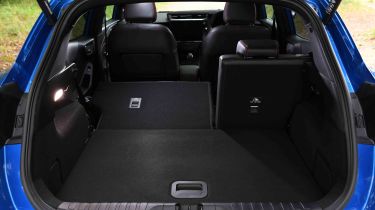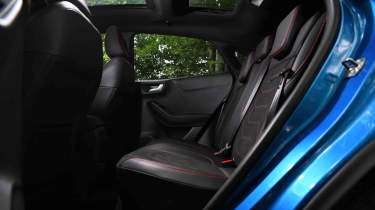Ford Puma - Boot space, comfort and practicality
The Ford Puma’s compact dimensions don’t compromise cabin space as much as you might expect

The Ford Puma isn’t quite class-leading for interior space and boot capacity, but given its small footprint, it makes great use of its size.
Like most of its rivals, the Puma is a five-door small SUV. It’s got five seats, although, if you have adults to transport, it is best thought of as a four-seater with just enough room for a fifth passenger for a short journey.
|
Dimensions | |
|
Length |
4,186mm |
|
Width |
1,805mm |
|
Height |
1,536mm |
|
Number of seats |
5 |
|
Boot space |
456-1,216 litres |
Dimensions and size
The Puma is one of the smaller options in the supermini-sized SUV class. It measures 4,186mm in length (4,226mm for the ST), 1,805mm wide and stands 1,536mm tall. By comparison, the Peugeot 2008 and Mazda CX-30 are 114mm and 209mm longer, respectively.
How practical is the Ford Puma?
Seats & space in the front
The driving position feels sportier than most rivals due to good seat bolsters, while there’s a great deal of adjustment in the seat and steering wheel, a typical Ford trait.
Even though the Puma comes with a manual handbrake – which is a rarity on new cars these days – and a fairly chunky gear selector, there’s still sufficient space in the centre console for a neat triple cup-holder arrangement.
Elsewhere, there’s a large glovebox, and the door bins are wide and deep. A storage area is located under the central armrest, and inside it is a useful small tray so that items such as keys don’t completely disappear into the void.
Seats & space in the back
Look beyond the fact that the door cards, which are finished entirely in scratchy plastic, leave the rear occupants short-changed when it comes to quality, and the Puma offers up enough space for adults.
Used - available now
There is loads of foot space beneath the front seats for occupants to make the most of the knee room on offer, while even the centre seat, although a little narrow, is quite soft and comfortable. If you plan to carry tall passengers frequently, it’s best to avoid the panoramic sunroof option, because this compromises headroom.
Fitting a child seat is a little fiddly, however, because the two sets of ISOFIX mounts on the outer chairs are buried between the seat cushions.
Boot Space
A 456-litre boot (which grows to 1,216 litres with the rear seats folded) is impressive considering the Puma’s compact footprint. This capacity is helped by the Megabox storage area beneath the standard boot floor. This 68-litre plastic container has a drain plug at its bottom, which makes it ideal for stowing dirty items, such as boots, because it can be rinsed out once it gets grubby.
A 12-volt socket in the boot area means it’s also possible to power a range of accessories. One slight flaw comes with the parcel shelf, however. The fabric sheet is very flimsy and its clips fall apart easily. These soon broke on the pre-facelift Puma that we ran on our long-term test fleet, meaning what was, in effect, a brand-new model was quickly damaged.
Towing
The 123bhp version of the 1.0-litre EcoBoost engine can tow a small braked trailer weighing up to 1,100kg thanks to its manual gearbox, while the automatic used in the 153bhp version and the 168bhp ST reduces capacity to 900kg. That’s at the lower end of the scale, meaning those after more serious pulling power must go for the four-wheel drive ‘4Motion’ VW T-Roc, which can tow up to 1,700kg in both 2.0-litre petrol and diesel forms.














